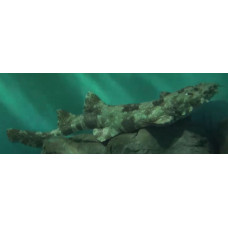Latin name
Orectolobus japonicus
Other names
Japanese carpet shark, fringed shark.
Identification
They have a flattened and broad head and body. There is a leathery fringe of five lobes under the eyes on each side. The fringe behind the spatula is broad and branched. Dermal tubercles and protuberances on the back are absent. The mouth is located in front of the eyes. The nostrils are located near the tip of the snout and communicate with the mouth through a groove. The anterior nasal valves reach the teeth. The fleshy antennae of the nostrils are high and twice as long as the eye. On the sides of the mouth are 4-5 skin growths. On the sides of the head there are two more two to three lobed projections.
Teeth
The teeth on the lower jaw have 8 rows on each side and the teeth on the upper jaw have 9 rows.
Features of fish fins
The base of the first dorsal fin begins at the midpoint of the bases of the pelvic fins. Dorsal spines (total): 0; Dorsal soft rays (total): 0; Anal spines: 0; Anal soft rays: 0. Caudal fin with upper lobe barely elevated above body axis, with strong terminal lobe and subterminal notch, but no ventral lobe.
Fish colouring
The colouring is very variegated, the light brown body is covered with dark saddle-shaped markings with irregular edges, flecked with white dots.
Distribution
They live in the western Pacific Ocean off the coasts of Japan, Korea, China and Vietnam.
Habitat
Marine, demersal species. Occurs in temperate and tropical waters on rocky and coral reefs, up to 200m deep. Prefers sandy or sandy-silt bottoms.
Size
The maximum recorded length is 107 cm.
Behavior
They're nocturnal.
Food and feeding habits
The diet consists of benthic bony fish such as lizardfish, cutlass, Atlantic horse mackerel, mullus, epinephelus, tilefish, gurnard, merluccius, parrotfish, sparidae, sciaenidae, rays, shark eggs, cephalopods and shrimp.
Reproduction
They reproduce by laying eggs, with 20-23 newborns in a litter. They are capable of breeding in captivity. These sharks have been observed mating in an aquarium in Okinawa, Japan. Births followed from March to May. During the mating process, the male would grab the female in the gill area and then mate with her. Pregnancy lasts about a year. Males and females reach sexual maturity at 103 cm and 101-107 cm respectively.
Fishing
The species is of little commercial interest.
Relationship with a person
Potentially dangerous due to their impressive size. The flesh is used for food. They are kept in aquariums in Japan and the USA.
| Classification | |
| Phylum | Chordata |
| Class | Chondrichthyes |
| Squad | Orectolobiformes |
| Family | Orectolobidae |
| Genus | Orectolobus |
| Species | O. japonicus |
| Features | |
| Conservation status | Least Concern |
| Habitat | Bottom |
| Life span, years | No information |
| Maximum body weight, kg | No information |
| Maximum length, cm | 107 |
| Sailing speed, m/s | No information |
| Threat to people | Edible |
| Way of eating | Predator |
Japanese wobbegong
Tags: japanese wobbegong



